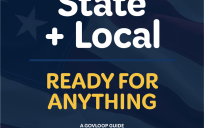adrielhampton.com – The intent of my blog is to increase the acceptance and practice of Web 2.0 concepts in governance. I believe in a basic libertarian ideal of self-determination, but also in a strong central government to provide security and a baseline standard of living and health. Underpinning my political philosophy is a raging populist spirit.
I want to see people engaged in their government, paying attention to and demanding response from their elected representatives. Web 2.0 tools and the rapidly decreasing costs of communication and connecting is engendering one of the greatest shifts in our democracy in a generation. Central to this revolution is the “Citizen 2.0″ (the term was recently used by my friend Andrea Baker in an opinion piece on social media and transparency in government, but still lacks a Wikipedia entry). The Citizen 2.0 is engaged with their government through media technologies that allow near instantaneous spread of news, and simple means to “crowdcast” a response to both officials and friends and neighbors. The Citizen 2.0 participates in their government from a position of knowledge and speed.
The tools of Web 2.0 will allow this revolution, but it is the job of we initiates to make this revolution work.
It is not enough for Web 2.0/Gov 2.0 enthusiasts to talk to each other and write in blogs and tech magazines. This social network is a good start. Government 2.0 will advance as these more local, state and federal employees realize the incredible value of quick and cheap horizontal communication.
Commercial applications of 2.0 are also spreading quickly, due to the potential of the tech to make money by embedding products deeper into the collective consciousness and allowing brands and customers to interact on a more personal level.
The challenge I’m presently most cognizant of is spreading the Citizen 2.0 meme. This means taking the tools out of the chatterboxes and to the streets. It means teaching citizen activists how to engage their government with tools like Facebook campaigns, Twitter, niche social networks and blog campaigns. It means going from the activists to the everyday folks who find government inaccessible and hold to the fast-fading power of the adage, “Can’t fight City Hall.”
We can make government work for the people, and we must be willing to lead.




The local governments are really going to have to take the first step in establishing and then promoting these tools first. After that I really think that it will spread like wildfire. I have to keep going back to Obama’s campaign. Everything was right there at the people’s fingertips and the more people took part in the campaign, at the grassroots level, the more word of mouth spread. Another good example is the Opponents of Prop 8 here in California (though they couldn’t get this together BEFORE election day). They have used Twitter, Facebook, MySpace and a million blogs all over the place to really engage people and organize huge protests and vigils. Opinion on Prop 8 regardless, it’s a good example of getting people involved and active using these web 2.0 tools. I really wish my hometown would get on the ball and start taking advantage of these tools! People are online, they are ready to be engaged and ready to be involved, they just needs the means. Citizen 2.0, I love it! Count me in.
I agree Meghan,
Folks have not tried some of the tools available. I think one point of fear comes from flame wars and free speech on tax-supported websites. I’m hoping to start with email “contact us” buttons on elected official’s pages and pertinent subjects and departments. One, small, cheap step at a time.
Good point, Ed, sometimes the starting point is 0.0! I think the approach, especially from a public service perspective, is to go to people where they are at: “How would you like to interact with your government? Yeah, well here is a way the Internet can help.”